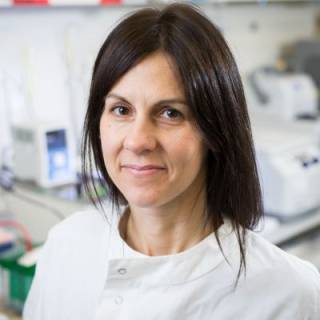Dr Suzana Hadjur and colleagues' work on the three-dimensional organisation of the genome could have implications across a range of cancers.
Control of gene expression plays a key role in establishing and maintaining cell identity, and disruptions to gene expression programmes can lead to the development of cancer. Often, control elements are located close to the genes that they regulate, but some are found considerable distances away from their target genes. However, looping of the linear DNA molecule can bring distant sites closer together within the three-dimensional space of the nucleus.
A key role in the three-dimensional organisation of the genome is played by a protein complex known as cohesin. Cohesin was first identified as a ring-like structure that held sister chromatids together during the DNA replication phase of cell division. However, it was soon found that cohesin also played a role in control of gene expression, in collaboration with a binding partner, known as CTCF. Dr Hadjur and colleagues showed that CTCF cooperates with cohesin to bring genes and distant control elements into close physical proximity [1].
CTCF is a zinc finger protein that binds to a specific DNA motif widely distributed in the genome. Cohesin then acts as a tether that brings otherwise distant CTCF-binding sites closer together, creating DNA loops that demarcate semi-independent sub-chromosomal domains. Indeed, disruption of these loops in the absence of cohesin has a significant impact on gene expression within entire domains, suggesting that cohesin's role extends to stabilising gene expression programmes over extended genomic regions [2].
Furthermore, a comparison across mammalian species showed that patterns of chromosomal looping are highly conserved - further evidence of their functional significance - and that alterations to CTCF-binding sites have played a key role in evolutionary change [3].
The cohesin complex is of great interest in cancer biology as mutations in its subunits have been found in a striking range of tumours - identifying it as a pan-cancer target. Given its key role in chromosome separation, disrupted cohesin function could lead to large-scale chromosomal abnormalities such as aneuploidy. Notably, however, not all of cancers with cohesin mutations show signs of aneuploidy, suggesting that disrupted gene expression may instead be driving cancer.
Targeting the cohesin-CTCF system will require a deeper understanding of its regulation and contribution to control of gene expression. Dr Hadjur is now focusing on the molecular basis of interactions between cohesin and CTCF, as well as the multiple regulators that control their binding. She is also exploring how the levels of different cohesin subunits change during development, to unpick their possible roles in specification of cell identity.
- Hadjur S et al. Cohesins form chromosomal cis-interactions at the developmentally regulated IFNG locus. Nature. 2009;460(7253):410-3.
- Sofueva S et al. Cohesin-mediated interactions organize chromosomal domain architecture. EMBO J. 2013;32(24):3119-29.
- Vietri Rudan M et al. Comparative Hi-C reveals that CTCF underlies evolution of chromosomal domain architecture. Cell Rep. 2015;10(8):1297-309.
 Close
Close


